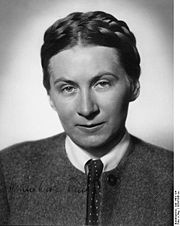
Gertrud Scholtz-Klink
Encyclopedia

Nazi Germany
Nazi Germany , also known as the Third Reich , but officially called German Reich from 1933 to 1943 and Greater German Reich from 26 June 1943 onward, is the name commonly used to refer to the state of Germany from 1933 to 1945, when it was a totalitarian dictatorship ruled by...
.
Nazi activities
She married a factory worker at the age of eighteen and had six children before he died.Scholtz-Klink joined the Nazi Party and by 1929 became leader of the women's section in Berlin. In 1932, Scholtz-Klink married Guenther Scholtz, a country doctor (divorced in 1938).
When Adolf Hitler
Adolf Hitler
Adolf Hitler was an Austrian-born German politician and the leader of the National Socialist German Workers Party , commonly referred to as the Nazi Party). He was Chancellor of Germany from 1933 to 1945, and head of state from 1934 to 1945...
came to power in 1933, he appointed Scholtz-Klink as Reich's Women's Führer and head of the Nazi Women's League. A good orator, her main task was to promote male superiority and the importance of child-bearing. In one speech, she pointed out that "the mission of woman is to minister in the home and in her profession to the needs of life from the first to last moment of man's existence."
Despite her own position, Scholtz-Klink spoke against the participation of women in politics, and took the female politicians in Germany of the Weimar Republic as a bad example, saying, "Anyone who has seen the Communist and Social Democratic women scream on the street and the parliament, realize that such an activity is not something which is done by a true woman". She claimed that for a woman to be involved in politics, she would either have to "become like a man", which would "shame her sex", or "behave like a woman", which would prevent her from achieving anything.
In July 1936, Scholtz-Klink was appointed as head of the Woman's Bureau in the German Labor Front, with the responsibility of persuading women to work for the good of the Nazi government. In 1938, she argued that "the German woman must work and work, physically and mentally she must renounce luxury and pleasure", though she herself enjoyed a comfortable material existence.
Scholtz-Klink was usually left out of the more important meetings in the male-dominated society of the Third Reich, and was considered to be a figurehead. She did, however, have the influence over women in the party as Hitler had over everyone else.
By 1940, Scholtz-Klink was married to her third husband SS-Obergruppenführer August Heissmeyer
August Heissmeyer
August Heißmeyer was a leading member of the SS. After the World War II, he was sentenced to a prison term as a war criminal. His nephew, Kurt Heissmeyer, an SS physician, was as well.-Life:After finishing school, Heißmeyer joined the Prussian military...
, and made frequent trips to visit women at Political Concentration Camps.
Post-war life
After the fall of the Third Reich, in the summer of 1945, she was briefly detained in a Soviet prisoner of war camp, but escaped shortly after and went into hiding in Bebenhausen Castle near TübingenTübingen
Tübingen is a traditional university town in central Baden-Württemberg, Germany. It is situated south of the state capital, Stuttgart, on a ridge between the Neckar and Ammer rivers.-Geography:...
. She and her third husband spent the subsequent three years under the aliases of Heinrich and Maria Stuckebrock.
On 28 February 1948, the couple were identified and arrested. A French military court sentenced Scholtz-Klink to 18 months in prison on the charge of forging documents. In May 1950, a review of her sentence classified her as the "main culprit" and sentenced her to additional 30 months. In addition, the court imposed a fine and banned her from political and trade union activity, journalism, and teaching for ten years.
After her release from prison in 1953, Sholtz-Klink settled back in Bebenhausen.
In her 1978 book Die Frau im Dritten Reich ("The Woman in the Third Reich"), Scholtz-Klink demonstrated her continuing support for the National Socialist ideology. She once again upheld her position on National Socialism in her interview with historian Claudia Koonz
Claudia Koonz
Claudia Ann Koonz is an American feminist historian of Nazi Germany. Her principal area of interest is the experience of women during the Nazi era.-Career overview:...
in the early 1980s.
She died on 24 March 1999 in Bebenhausen
Bebenhausen
Bebenhausen is a village in the Tübingen district, Baden-Württemberg, Germany. Since 1974 it is a district of the city of Tübingen, its smallest one. It is located 3 km north of Tübingen proper , in the southeastern part of the protected landscape of the Schönbuch, a dense forest...
, Germany.
Publications
- Scholtz-Klink, Gertrud (1978). Die Frau im Dritten Reich. Tübingen: Grabert.
Further reading
- Livi, Massimiliano (2005). Gertrud Scholtz-Klink: Die Reichsfrauenführerin. Münster: Lit-Verlag. ISBN 978-3-8258-8376-8
- Sigmund, Anna (2001). Nazisternas kvinnor ("Nazi Women")

